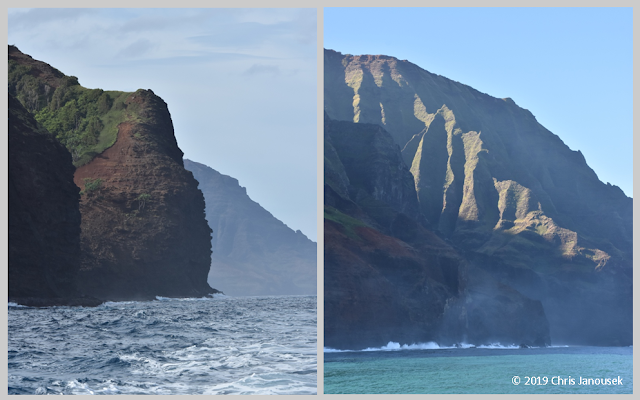The Kalalau trail traverses the famous northwestern coast of
Kaua’i in what I presume is one of the most scenic hiking trails anywhere in
the United States
That unfortunate news left just a few other options to see
this dramatic coastline. We availed ourselves of two of these: ridge-top hiking
trails accessible from Kokee
State Park
The Napali Coast reminds me of Big Sur in central California where in both cases steep coastal mountains
abruptly meet the gorgeous Pacific Ocean . The
mountains of the Napali coast are more deeply sculpted and luminous than Big Sur , but both are examples of breathtaking coastal
wilderness.
 |
| Napali coast cliffs from offshore. |
 |
| Spinner dolphins astride the boat near the Napali coast. |
We pulled closer to shore at several locations along the
Napali coast and anchored at one for a chance to snorkel offshore. The site was
in about 10 m of water though I swam in towards shore with my two older kids to
a shallower area. Water clarity was decent, though I enjoy swimming in pretty
shallow areas when possible because they offer more opportunity to see the
small biota on the reef. I was about the last person to hop back on the boat,
hoping to spend as much time as possible in the water.
 |
| Fishes at our snorkeling spot along the Napali coast. |
Our other views of the Napali coast were from above. One
must actually circle all around the island from the Kalalau trail, head up the
steep road that traverses the west side of Waimea Canyon
 |
| View from the Awaawapuhi trail. |
We descended down onto one of the ridges via the Awaawapuhi
trail. The coast wasn’t visible at all for the first two miles or so but then
the trail ran along a narrow saddle with ravines to the north and south. After
another mile and a half it ended, and opened up to a spectacular view of the
Pacific from a high point with views to the north and south. A rainbow graced
the coastline to the north for a few minutes.
I actually ended up taking a second excursion to the Napali Coast shore of Nihau
 |
| Small coastal waterfall. |
 |
| Spinner dolphins. |
 |
| Rainbow at the end of the Awaawapuhi trail. |






